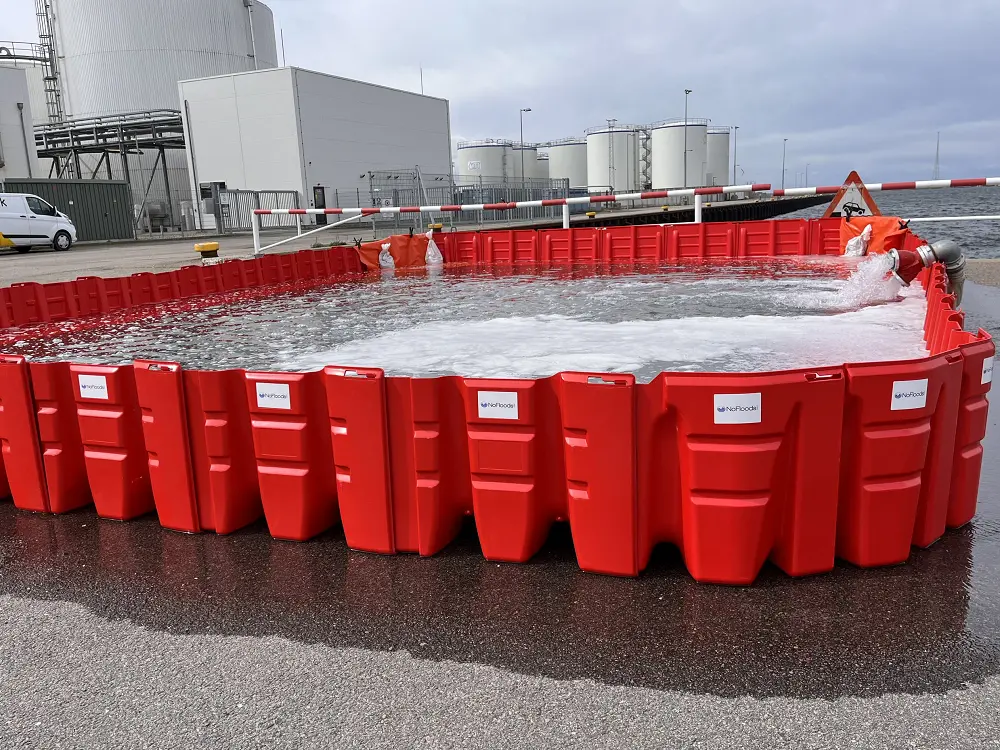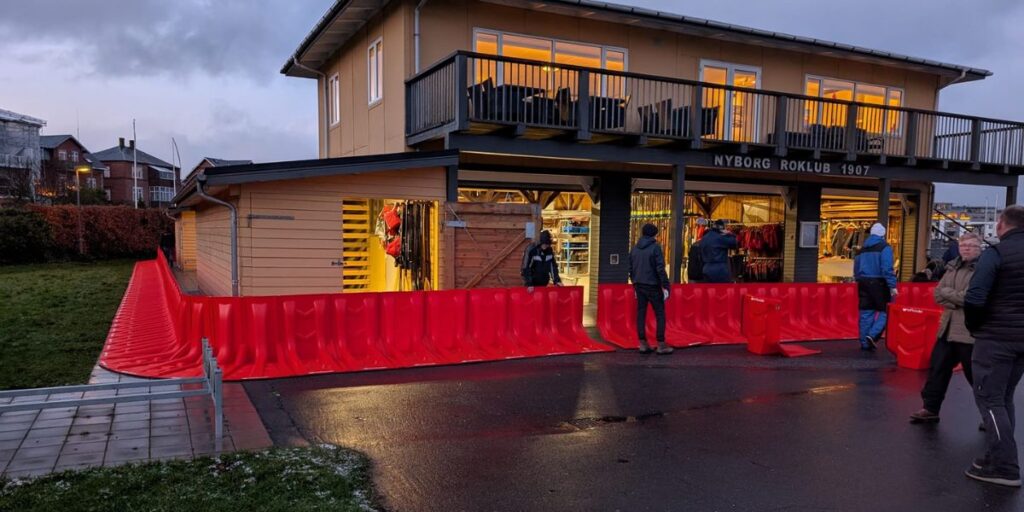The L-shaped flood barrier is quickly becoming a game-changer in flood defense as it represents a paradigm shift in how communities can effectively manage flood risks. Users value the low footprint and ease of use, which align with the requirements of the urban environment.
As cities seek sustainable methods for mitigating flood risks, understanding the mechanics and benefits of the L-shaped barrier could be pivotal in safeguarding lives and property.
In this post, we’ll explore how this game-changing barrier is poised to redefine flood protection for future generations.
Key Benefits of L-Shaped Flood Barriers
Fast and Easy Deployment: The barrier can be quickly set up, reducing the time needed to protect an area compared to traditional methods.
Lightweight and Portable: Made from ABS plastic, the barrier is light enough for easy transportation and handling but strong enough to hold up against rising waters.
Reusable and Durable: Unlike sandbags, which are often discarded after use, L-shaped barriers can be reused multiple times, offering a sustainable and cost-effective solution.
Minimal Environmental Impact: The high-quality plastic used in these barriers is durable with less waste generated compared to disposable methods.
Versatile Applications: Suitable for both temporary and semi-permanent installations, the barrier can be tailored to meet the unique needs of different flood scenarios.
What Exactly Is an L-Shaped Water Barrier?
An L-shaped water barrier gets its name from its shape that looks like the letter “L” – one side lies flat on the ground, and the vertical side faces the oncoming water.
This L-shaped design allows the barrier to resist water pressure more effectively by distributing the force across its base.
It’s made of high-quality ABS plastic which is not only durable but also lightweight, making it easy to handle and move when needed.
The ABS plastic ensures the barrier can withstand extreme conditions while being resistant to corrosion and wear over time.
The simplicity of its design makes it a versatile choice for various flood-prone environments.
How Does the L-Shaped Barrier Work?
The L-shaped barrier is engineered to harness the natural force of the water it’s protecting against.
As floodwaters rise, they push against the vertical part of the “L”, transferring force to the base which helps keep the barrier stable.
This design cleverly uses the water’s own pressure to anchor itself, making it highly effective at withstanding the pressure of incoming water.
Recommended Areas for Deployment
The L-shaped water barrier is most effective when deployed on hard, stable surfaces like asphalt and concrete, which are commonly found in urban environments.
These surfaces provide the necessary grip and support to prevent erosion and ensure the barrier remains secure under the pressure of floodwaters.
Areas with softer surfaces such as grass, gravel, soil or sand are not suitable for deployment.
This is because they can easily erode thus compromising the barrier’s stability and preventing it from functioning as intended.
For optimal performance, always choose firm, non-erodible surfaces like asphalt and concrete.
NOTE: For these softer areas, the NoFloods Barrier or FlexWall is recommended.
These innovative solutions are designed to adapt to various terrains, providing effective flood protection even on less stable ground while ensuring reliable performance.
Installation Process: Step-by-Step Guide
Step 1: Site Preparation: Clear the area where the barrier will be deployed, ensuring it’s free of large debris that could interfere with placement.
Step 2: Position the Barriers: Arrange the barriers along the desired perimeter.
Step 3: Connect the Units: Link multiple units together securely to form a continuous line of protection.
Step 4: Stabilize the Barriers: Allow the floodwaters to push against the vertical side of the barriers, ensuring that the base remains firmly grounded.
Step 5: Monitor and Adjust: Keep an eye on the barriers as water levels rise, making any necessary adjustments for optimal performance.
IMPORTANT TIP: It’s recommended to install a small water pump on the dry side (the area you’re protecting) to remove any water that may seep through or under the barrier.
Advantages Over Traditional Barriers
When comparing the L-shaped flood barrier to traditional flood defenses like sandbags, the differences are clear:
Speed: It can be deployed faster than sandbags which require manual stacking and filling.
Labour Efficiency: While sandbags require teams of people to manage, L-shaped barriers can be set up by just a few individuals.
Durability: Sandbags can break down or become waterlogged while the ABS plastic used in L-shaped barriers is far more resistant to wear and tear.
Environmental Impact: Unlike sandbags which are often discarded after use, L-designed barriers can be reused, resulting in less waste and a smaller ecological footprint.
Environmental Impact and Sustainability
The L-shaped flood barrier is made from ABS plastic which not only provides strength but is also recyclable.
This minimizes waste and supports sustainable flood management.
Unlike sandbags which often end up in landfills, L-designed barriers offer a better solution for communities focused on reducing their environmental footprint.
Maintenance Tips for Longevity
Follow these simple tips to ensure that the barrier lasts as long as possible:
Clean After Use: After each deployment, rinse off any dirt or debris to prevent buildup.
Inspect Regularly: Check for any signs of wear or damage, especially at the connecting joints.
Store Properly: When not in use, store the barriers in a dry-covered area to protect them from the elements.
Repair When Needed: If any small cracks or damage occur, address them quickly to prevent further deterioration.
Real-World Applications of L-Shaped Flood Barriers
L-shaped barriers have been successfully used in a variety of settings – from protecting residential properties to safeguarding vital infrastructure.
Thanks to their quick deployment and effectiveness, these barriers have minimized flood-related losses, helping communities save on repair costs.
The barrier’s adaptability also allows it to be customized for different environments – whether it’s a city, a rural community or an industrial area.
NoFloods L-Shaped EasyWall Barrier: The Smart Choice for Reliable Flood Protection
Among the most innovative solutions available when it comes to L-shaped flood barriers is the EasyWall.
This L-shaped barrier combines the strength of modern flood defenses into one efficient and easy-to-deploy system.
Here’s a video of the EasyWall in action.
Constructed from high-quality ABS plastic, the EasyWall is engineered using injection moulding with UV protection ensuring it is both lightweight and durable.
This also makes the barrier easy to handle and deploy in various environments.
It’s built to withstand a wide range of conditions, functioning effectively in temperatures between -20°C to +35°C.
This ensures reliable protection in diverse weather scenarios, making it a versatile and resilient choice for flood defense.
The Easywall models offer protection heights ranging from 50 cm to 108 cm, with weights between 4 kg and 13 kg.
It’s also worth noting that different models can be combined using the NoFloods membrane for enhanced protection.



Whether you’re dealing with temporary flooding or seeking a semi-permanent solution, the L-shaped EasyWall barrier delivers unmatched reliability.
If you’re looking to invest in a flood protection solution that’s built to last, L-shaped flood barriers like the EasyWall offer a comprehensive defense strategy.
So don’t wait for the next flood – secure your property and safeguard your community with a solution that is not only practical but also sustainable for the future.



